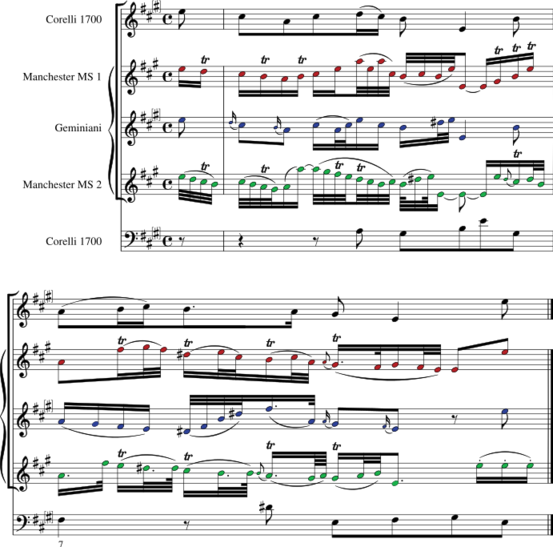Performing Corelli's Op. 5 violin sonatas: Difference between revisions
m moved Performing Corelli's Op. 5 to Performing Corelli's Op. 5 violin sonatas: Being more explicit in title |
|||
| (4 intermediate revisions by the same user not shown) | |||
| Line 1: | Line 1: | ||
This | ==Performing Corelli's violin sonatas Op. 5== | ||
Corelli's violin sonatas are associated with a long trail of manuscripts demonstrating different ways to enhance the violin part. This trail extends for almost two centuries beyond the original publication date of 1700. Numerous studies have examined the various techniques involved. The noted musicologist Neal Zaslaw, collected and transcribed 15 of these alternative versions in the 1990s, observed that in some cases the elaborations were so free that they failed to conform to the original harmonic scheme. (More than 20 manuscript sources for Op. 5 are now known.) | |||
The piece for which the largest number of elaborations is Op. 5, No. 9. We reproduce here three versions (Staves 2, 3, and 4) of the first two bars of its opening Preludio. | |||
[[Image:Corelli-op5n9m1b1-2.svg||center]] | [[Image:Corelli-op5n9m1b1-2.svg||center]] | ||
Corelli's original material is given on Staves 1 and 5. Although we do not know who prepared the the two versions in the Henry Watson Music Library in Manchester, UK, it is likely that both come from roughly 1720-1740. The violin virtuoso Francesco Geminiani (1687-1762; see Staff 3) was a pupil of Corelli (c. 1704-06), was greatly revered in England and Ireland, where, from 1714, he spent most of his life. Many of the known variations of Op. 5 can be associated with English pupils of Geminiani. | |||
In his later years he arranged works by other composers. Among these reworkings were concerto grosso settings of Corelli's violin sonatas, Op. 5. In his <i>Art of Playing the Violin</i> (1751) he gave considerable attention to ornaments. Some of his recommendations, particularly for avoidance of metrical accentuation, were controversial. The placement of trills on weak beats (Manchester 1, Bar 1) would seem to be an exemplification of his advice. Even among versions from the early part of the century one finds a wide variety of approaches. The beats that are significantly subdivided, and the contours their subdivisions take, can fall on any beat of the measure. In this respect, the latitude for interpretation was notable broad. | |||
Over his long life, Geminiani was involved in a wide variety of musical and theatrical situations. Subsequent to <i>The Art of the Violin</i>, he also wrote <i>The Art of Accompaniment</i> (<i>c</i>. 1756) and <i>The Art of the Guitar</i> (1760). Geminiani's own elaborations of Corelli's violin sonatas are not preserved in the composer's hand, but Op. 5, No. 9, was reproduced in John Hawkins' <i>A General History of the Science and Practice of Music</i> (London, 1776). | |||
Few repertories of the time provide the same wealth of examples of continuous ornamentation. The February 1996 issue of <i>Early Music</i>, which is devoted entirely to questions surrounding Corelli's violin sonatas Op. 5, offers a starting point for violinists in search of more detail. The short quotations provided here merely suggestive of that wealth. | |||
Latest revision as of 20:03, 19 January 2011
Performing Corelli's violin sonatas Op. 5
Corelli's violin sonatas are associated with a long trail of manuscripts demonstrating different ways to enhance the violin part. This trail extends for almost two centuries beyond the original publication date of 1700. Numerous studies have examined the various techniques involved. The noted musicologist Neal Zaslaw, collected and transcribed 15 of these alternative versions in the 1990s, observed that in some cases the elaborations were so free that they failed to conform to the original harmonic scheme. (More than 20 manuscript sources for Op. 5 are now known.)
The piece for which the largest number of elaborations is Op. 5, No. 9. We reproduce here three versions (Staves 2, 3, and 4) of the first two bars of its opening Preludio.

Corelli's original material is given on Staves 1 and 5. Although we do not know who prepared the the two versions in the Henry Watson Music Library in Manchester, UK, it is likely that both come from roughly 1720-1740. The violin virtuoso Francesco Geminiani (1687-1762; see Staff 3) was a pupil of Corelli (c. 1704-06), was greatly revered in England and Ireland, where, from 1714, he spent most of his life. Many of the known variations of Op. 5 can be associated with English pupils of Geminiani.
In his later years he arranged works by other composers. Among these reworkings were concerto grosso settings of Corelli's violin sonatas, Op. 5. In his Art of Playing the Violin (1751) he gave considerable attention to ornaments. Some of his recommendations, particularly for avoidance of metrical accentuation, were controversial. The placement of trills on weak beats (Manchester 1, Bar 1) would seem to be an exemplification of his advice. Even among versions from the early part of the century one finds a wide variety of approaches. The beats that are significantly subdivided, and the contours their subdivisions take, can fall on any beat of the measure. In this respect, the latitude for interpretation was notable broad.
Over his long life, Geminiani was involved in a wide variety of musical and theatrical situations. Subsequent to The Art of the Violin, he also wrote The Art of Accompaniment (c. 1756) and The Art of the Guitar (1760). Geminiani's own elaborations of Corelli's violin sonatas are not preserved in the composer's hand, but Op. 5, No. 9, was reproduced in John Hawkins' A General History of the Science and Practice of Music (London, 1776).
Few repertories of the time provide the same wealth of examples of continuous ornamentation. The February 1996 issue of Early Music, which is devoted entirely to questions surrounding Corelli's violin sonatas Op. 5, offers a starting point for violinists in search of more detail. The short quotations provided here merely suggestive of that wealth.